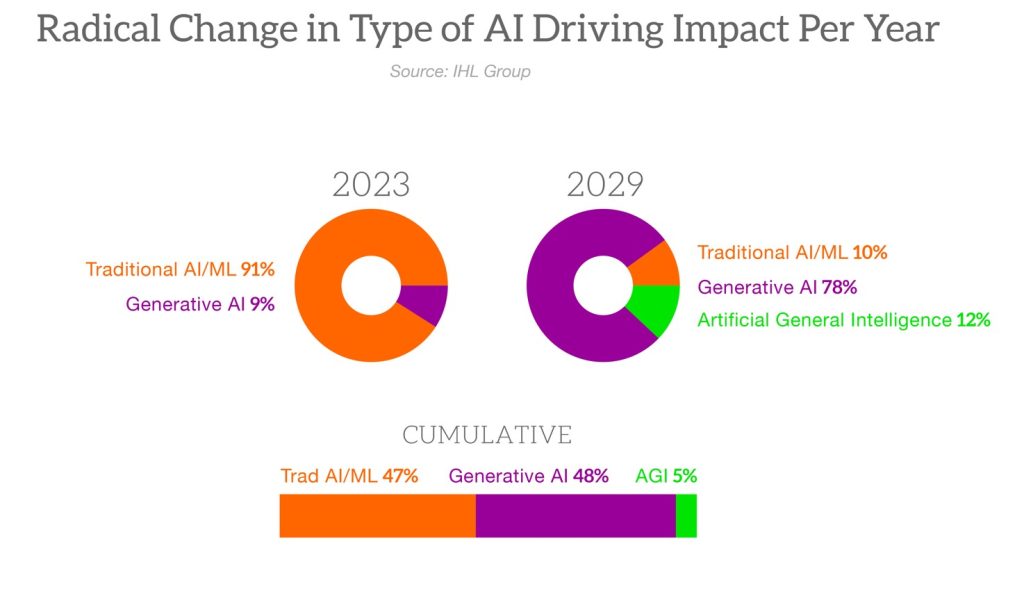Generative AI or Traditional AI/ML? Which will have a greater impact on Retail and Foodservice?
In the ever-evolving landscape of retail and hospitality, the adoption of artificial intelligence (AI) is revolutionizing the way businesses operate. According to IHL’s Retail AI Revolution Forecast Model, the numbers paint a compelling picture of the changing AI landscape and the transformative impact it will have on AI in Retail and Hospitality with a total economic impact of $9.2t through 2029.
According to the data, in the year 2023, traditional AI/machine learning (ML) techniques will account for an impressive 91% of all new economic impact in the retail and hospitality market. These traditional AI systems have already demonstrated their efficacy in areas such as inventory management, demand forecasting, personalized marketing, and customer service automation. Companies are leveraging these technologies to optimize operations, improve efficiency, and enhance the overall customer experience.
However, the real game-changer on the horizon is generative AI. By 2029, generative AI is projected to generate a staggering 78% of all new economic impact, leaving traditional AI/ML with just 10% and Artificial General Intelligence (AGI) with 12% of total economic benefit. This seismic shift in the AI landscape is driven by the unprecedented capabilities of generative AI to create, innovate, and transform the industry – building on the hard work retailers have already done cleaning, tagging and modeling data of traditional AI/ML.
Generative AI is set to redefine the shopping experience by providing highly personalized recommendations, immersive virtual try-on experiences, and even AI-generated product designs tailored to individual preferences. Imagine a virtual shopping assistant capable of understanding your unique style, suggesting new outfits, and seamlessly integrating with augmented reality to virtually showcase the items you’re interested in.
Retail giants are already harnessing generative AI’s potential. For instance, luxury fashion brands are utilizing generative AI algorithms to design unique and exclusive collections, resulting in products that are truly one-of-a-kind. This technology allows retailers to tap into the infinite possibilities of creativity, reducing time-to-market and meeting the ever-evolving demands of consumers.
While traditional AI/ML will maintain its significance, the cumulative economic impact from 2023 to 2029 is projected to be 47%. However, generative AI will represent an even higher share of 48%, highlighting its massive influence in shaping the future of retail and hospitality. AGI, though representing a smaller portion, will contribute an important 5% of economic benefit, looking to provide more innovation as we turn to the next decade.
In conclusion, the answer to our headline question is both. Traditional AI/ML systems are already paving the way, optimizing operations, and enhancing customer experiences. However, it is the rise of generative AI that promises to unleash a wave of innovation and personalization, revolutionizing how retailers engage with customers. As industry professionals, it is imperative that we embrace this paradigm shift and explore the possibilities that generative AI brings when combined with the data and models of traditional AI/ML.
Retail’s AI Revolution Forecast Model can be found here. A topline summary can be found here.
#AI #Retail #Hospitality #GenerativeAI #TraditionalAI #Transformation
